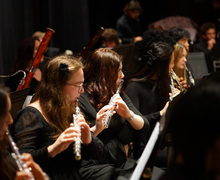‘We are not people in the past:’ Haudenosaunee Welcome highlights Indigenous strength
Vince Kang | Contributing Photographer
Mohawk National Council and Syracuse residents alike gathered on Monday evening for the Haudenosaunee Welcome Gathering. The event sparked contemporary discussions surrounding identity and remembrance, spreading awareness about important Indigenous stories.
Get the latest Syracuse news delivered right to your inbox.
Subscribe to our newsletter here.
Wakerahkáhtste Louise McDonald Herne, also called Mama Bear in the Mohawk Nation Council of Chiefs, welcomed the Syracuse University community for the fall semester Monday afternoon. During the traditional Haudenosaunee Welcome Gathering, she reminded attendees at the Shaw Quadrangle of the positive impacts of Indigenous peoples’ long-standing traditions.
“The more (Americans) lock ourselves away and disconnect ourselves from the natural course of nature, the more that we suffer,” Mama Bear said. “At one time, indigeneity was the alternative plan, but today it is the plan. It is the only plan.”
The Haudenosaunee Welcome is an annual event at SU. Diane Schenandoah, a member of the Oneida Nation and a Honwadiyenawa’sek (One who helps them) at the Barnes Center at The Arch, has helped host the gathering for the past four years. The event aims to juxtapose typical college welcome events with more poignant reflections on history and ongoing social issues.
When students go overseas, cultural experiences, like non-English language classes, are a curricular staple, Shenandoah said. The Haudenosaunee Welcome is intended to teach unfamiliar students about the land they walk on and the general message of Indigenous peoples.
“We are not people in the past,” Schenandoah said. “We are present, very much a part of today’s society.”
Javin Capella, a local high school freshman and member of the Onondaga Nation’s Eel Clan, delivered the Thanksgiving Address. He gave thanks to the Creator, a Haudenosaunee divine concept, for nature’s gifts.
“The people, the animals, the birds, food, water and give thanks so they keep continuing their duties and we thank them for that,” Capella said.
After Capella, Mama Bear discussed issues facing the American continent at length and stressed the importance of living in harmony with the natural world. These issues could be solved if people cooperate and make an active effort to preserve their environment, rather than compete and feel enmity toward one another, she said.
Mama Bear went on to cover topics concerning women’s body sovereignty, including the sterilization of Indigenous women by the United States Department of Health and Human Services in the 1960s and 1970s.
“I’m powered by my passion and my deep burning commitment to a bunch of women who are never seen and never heard because the system they were born into said they were too brown,” Mama Bear said.
After Mama Bear’s speech, Brandon Lazore, a local artist and member of the Onondaga Nation, spoke about an art installation on SU’s campus he helped design. The installation surrounds his painting, “Gayaneñhsä•ʔgo•nah,” which contains cultural symbols such as longhouses.
“There’s an older and a newer longhouse, and it represents the ability to adapt in changing times. Over the times we changed, and now that we’re inside a modern house, we still continue our culture and we still continue our way to this day,” Lazore said.
Lazore said Haudenosaunee governance informed early U.S. founders, such as Benjamin Franklin, who referenced Haudenosaunee concepts of unity in his plan for the U.S. Constitution.
“On the American seal, 13 arrows are held by the eagle, representing the unity of the 13 colonies, which references a Haudenosaunee concept of strength and unity in a bundle of five arrows,” Lazore said.
Both Mama Bear and Lazore informed students about topics as broad as historical conflicts and as local as SU’s art installations. For some Indigenous students, the event was affirming. Indigenous first-year transfer student Riley Thomas appreciated being able to see his flag while walking by on campus.
For others, it was a reminder of a dual cultural identity and the histories of assimilation and tradition.
“Being a Native student definitely creates a duality, because we belong to the Earth and we go to our ceremonies, but at the same time, we have to live in the world that we’re colonized and assimilated to live into,” said Timothy Williams, a freshman at SU.
Kayla Johns, a member of the Cayuga Nation and SU freshman, said that while she thinks SU is a better school for Indigenous students than some others, overall public awareness is still lacking.
The event closed with a traditional Haudenosaunee dance, where SU community members and visitors danced in a circle to the beat of drums.
“I tell everybody, you do yourself true justice and true truth. You go back in search of your original indigeneity, whether you’re from Africa, Asia, England, South America, Hawaii, wherever your original people are, find them,” Mama Bear said. “Know who you are, and don’t cookie cutter yourself into this insane world that we continue to propel ourselves in.”
Published on August 26, 2024 at 11:16 pm






